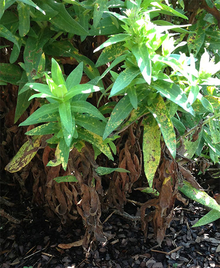Talking Plants
Jillian Patrie | University of Minnesota Yard and Garden Extension
Ever notice your socks and shoes turning orange after walking through a patch of grass, if you have it may have a common fungal disease called rust. Rust shows up on turf and ornamental grasses in late summer to early fall. It is most common on cool season grasses in Northern climates that have started to slow down their growth.
Nitrogen deficiencies and dry conditions can be another cause for turf growth to slow down, which can result in more outbreaks. To prevent rust in turf and ornamental grasses, allow grass to dry out before nighttime, by watering in the morning. A consistent cycle of maintenance for watering, mowing and fertilization will keep turf grasses healthy and less likely to turn orange.
Rust in flower gardens is common too and will appear as brown or orange spots on leaves. You may see this on Asters in the late summer and early fall, where lower leaves turn brown and fall off. Don’t purchase plants that are showing signs of rust, remove leaves that have rust, clean up plant debris from the garden at the end of the growing season to keep rust from returning next year. Reducing moisture on plants with proper watering and spacing can help prevent the appearance and spread of rust as well.
Rusts can show up in odd ways, cedar apple rust needs two different plants to complete its life cycle. This fungal disease needs cedar or juniper for the overwintering cycle and in wet spring weather spores are released from gooey orange growths that appear on the needles. The spores then are carried by wind to apple, Hawthorne or other plants in the Rosaceae family.
The leaves will develop leaf spot and fruit infections. The spores from these leaf spots cannot re-infect the apple or hawthorn and need to be carried to new needles on juniper or red cedar trees. To prevent this fungal disease from happening it is recommended to avoid planting trees in the Rosaceae and Cupressaceae (Juniper/Cedar) family in proximity of each other. Other options include selecting rust-resistant varieties of apple, crabapple, juniper and cedar. For the entire article on cedar apple rust and rust-resistant varieties take a look at this extension article https://extension.umn.edu/plant-diseases/cedar-apple-rust.
When the symptoms of fungal diseases appear, it is too late to repair damage with a fungicide, however fungicides can be used preventatively to protect new growth. Good maintenance practices are recommended for keeping disease issues at bay. Take a look at this article for more information on ways to keep your garden fungi free https://extension.umn.edu/plant-diseases/rust-flower-garden.
For more information on plant diseases visit https://extension.umn.edu/yard-and-garden.
For local assistance please contact Clay County Horticulture Educator, Jill Patrie at 218-299-7338 or by email at patri350@umn.edu.


